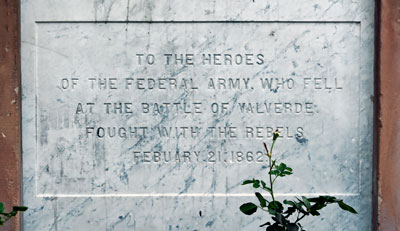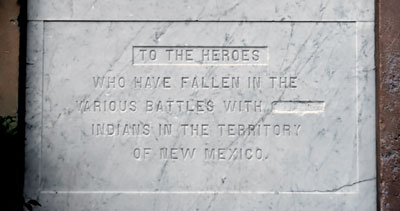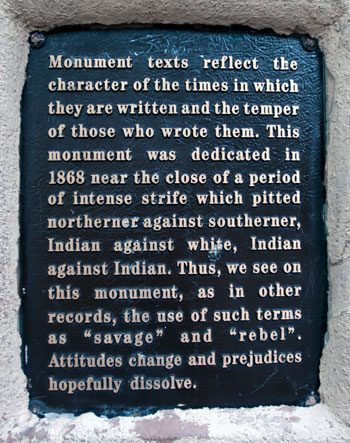National Register of Historic Places in Santa Fe County


To the heroes of the Federal Army
Who fell at the Battle of Valverde
Fought with the Rebels
February 21, 1862

To the heroes
Who have fallen in the
Various battles with savage
Indians in the Territory
Of New Mexico
Who is offended by the word "rebel" as applied to a Confederate soldier?
All Photos 9 August 2007
(Click Photos to Zoom)
Santa Fe Plaza
Santa Fe Plaza
Santa Fe
In the winter of 1609, Don Pedro de Peralta, third governor of the Province of Nuevo Méjico, established the settlement of Santa Fe with the construction of a palacio for a fortress, the laying out of a plaza and the erection of a wall around the settlement. The plaza was an open expanse of packed dirt twice as large as it is today. The social elite built their houses on three sides of the plaza.
In 1821, when Mexico gained independence from Spain, the plaza was named La Plaza de la Constitucion. A trade route to Santa Fe from the United States was opened and trade began on the Santa Fe Trail with the plazas the goal for the caravans on their eight or ten week journeys. The wagons were parked and unloaded on the plaza and weary traders spread out over the town in search of refreshment and entertainment.
On the plaza in 1846, General Kearny proclaimed the annexation of New Mexico to the United States. Activity on the Santa Fe Trail decreased. The plaza was fenced in and planted with alfalfa, and reduced to half its size.
Today, the plaza is shaded by large cottonwood trees and crossed with concrete walks. A monument marks the end of the Santa Fe Trail. An obelisk commemorates Indian Wars and the Unite States Civil War. A marble slab marks General Kearney's proclamation of the annexation of New Mexico. The Palace of the Governors stands north of the plaza. Shops and stores line the other three sides.
Source: Adapted from the NRHP nomination submitted in 1966.

The Battle of Valverde was fought during the American Civil War. One side were Confederate cavalry from Texas and militia from Arizona. On the other side were United States Army regulars and Union volunteers from northern New Mexico and the Colorado Territory.
Confederate Brigadier General Henry Hopkins Sibley invaded New Mexico in an attempt to capture Santa Fe then march west to conquer California and add it to the Confederacy. The Union forces were commanded by Colonel Edward Canby. The First Infantry of the New Mexico Volunteers was commanded by Colonel Kit Carson.
The battle took place on February 21, 1861. In the late afternoon, Canby sent a white flag asking for a truce to remove the bodies of the dead and wounded. Canby's forces retreated leaving the road toward Santa Fe open to the Confederates who captured Albuquerque and Santa Fe.
In March of 1862, Canby forced the Confederates to retreat to Texas after the Battle of Glorieta Pass.
Canby was promoted to Brigadier General. Sibley was given minor commands in Southern Louisiana.
In 1873, Canby was killed during peace talks with the Modoc tribe in northern California. He was the only United States general to be killed during the Indian Wars.

A disclaimer on the base of the obelisk reads:
Monument texts reflect the character of the times in which they are written and the temper of those who wrote them. This monument was dedicated in 1868 near the close of a period of intense strife which pitted northerner against southerner, Indian against white, Indian against Indian. Thus, we see on this monument, as in other records, the use of such terms as "savage" and "rebel." Attitudes change and prejudices hopefully dissolve.

Attitudes change and prejudices hopefully dissolve.
Isn't it pretty to think so?
